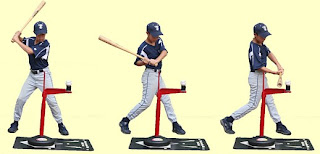By Guest Author Jack Perconte
Nothing is more frustrating for young baseball players and their parents than strike outs, especially if it is a recurring event. Strike outs may lead to very depressed ballplayers and to upset coaches and parents. Obviously, continual strike outs lead to athletes losing confidence, self-esteem and usually their desire to play the game altogether. What to do?
First, explain to ballplayers that hitting a baseball is one of the toughest things to do in sports and good fundamentals, practice and patience are necessary. Further explain that there are very few kids that have natural swings and the necessary hand-eye coordination to automatically be able to hit a ball. This explanation is important so players do not get too frustrated and depressed and to give them the message that they have control over the situation if they are willing to put in the work.
Next, the results of the hitter's at-bats must be analyzed. Sometimes, it is just a matter of the hitter becoming a little more aggressive when batting so they are not always behind in the count. Unaggressive hitters find themselves hitting with two strikes too often. If that is not the problem, check the results of the player's swings and misses. Are they under the ball (most common), over the ball, early or late? This will lead to what needs to be done.
Following are possible solutions for each of these situations:
1. When hitters are continually swinging late at the pitch - challenge them with higher velocity that approximate game speeds. Many hitters will make the necessary adjustments on their own when they begin to see faster speeds and get their eyes used to seeing the faster pitching.
2. Similar advice - when hitters are continually early they need to face much slower pitching so they learn to wait on the ball.
3. When hitters are under the ball they need to shorten the swing. This means keeping their swing path more direct by keeping the barrel of the bat above the ball on the approach to the ball. This can be done in a number of ways including the following drills.
Hitting Drill - With the use of two batting tees set the tees a bout a foot apart and in line with each other. Place a ball on both tees with the ball closer to the catcher about a balls width lower than the ball out front. Hitters should work on hitting the ball closest to the pitcher while missing the back ball.
Hitting Drill - Along the same lines as the previous drill, set the height of the batting tee a little above the back hip and place the tee under the hitter's hands in their stance. Pitch balls to the hitter and have them swing over the tee on the way to contact. This will help hitters develop a more direct swing path and should lead to more consistent contact.
4. When hitters are over the ball they should work on knee high pitches until they can begin to hit line drives on this pitch location. This will help them get use to driving their hands to the back of the ball while using their hips and legs in the correct way.
It is important to note that habits are tough to change and that there are times when I use "opposite drills" to change a players habits. These drills are extremely different then what the player is doing and often are not the fundamentally sound swing either, but they are the only way the hitter can break their initial bad habit. The hitting drills under point number 3 above could be considered opposite drills compared to what happens in reality with a great swing. The goal is to eventually meet in the middle with the correct swing and this is a way of doing that.
Finally, a great way to prevent strikeouts and promote more consistent contact is with front arm work. The hitters lead arm (hand) is the one that takes the bat to the ball so swinging the bat with just the lead arm will help contact. This drill will force the hitter to use the lead arm and get stronger with the front side, which is often the hitter's weaker arm.
Former major league baseball player, Jack Perconte gives baseball hitting tips and batting practice advice for ballplayers of all ages. His baseball playing lessons, books and advice can be found at http://www.baseballhittinglessons.com/baseball. Jack is the author of two books, The Making of a Hitter and Raising an Athlete - his positive parenting advice and books can be found at http://positiveparentinginsports.com.
Article Source: http://EzineArticles.com/?expert=Jack_Perconte
===================

Thanks to our Sponsor: Advanced Skills Tee
AdvancedSkillsTee.com
Advanced Skills Tee at Baseball2u.com
Advanced Skills Tee Reviews
Advanced Skills Tee Product Description
Used By Over 1,200 High Schools and Colleges!

No comments:
Post a Comment
Hello Baseball Friend,
I welcome any comments or suggestions. If you have a question or a topic that you would like to read about, please leave a comment and I will try to address that topic as soon as I can. Good luck in the coming season!
Have a great day, Nick